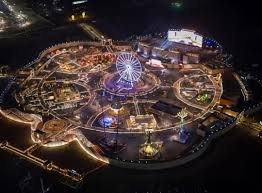Deep in the mesmerizing dunes surrounding Liwa Oasis, at the edge of the Rub’ al Khali (Empty Quarter), lies one of nature’s most puzzling creations – the so-called “Liwa’s Fairy Circles” of the UAE. These perfect circular patches of bare sand, each surrounded by a lush ring of desert grass, form strange polka-dot patterns across the landscape that can stretch for kilometers. While similar phenomena exist in Namibia’s deserts, the Liwa circles possess unique characteristics that have baffled scientists and inspired Bedouin legends for generations. The circles range from small 1-meter rings to expansive 15-meter diameters, maintaining their perfect form for years before suddenly vanishing and reappearing elsewhere. This mysterious life cycle, combined with their geometric precision in such an unpredictable environment, makes them one of Arabia’s most captivating natural wonders.
Liwa’s Fairy Circles: The Scientific Puzzle That Defies Explanation
Researchers have proposed multiple theories to explain Liwa’s fairy circles, yet none fully account for all their peculiarities. The most accepted hypothesis suggests they result from complex plant interactions – the grasses organize themselves to maximize water access in the hyper-arid environment. However, soil moisture measurements show the barren centers actually contain more water than the vegetated edges, contradicting this theory. Another study proposed termite activity, but extensive digging revealed no nests or insect colonies beneath the circles. In 2021, a UAE University team discovered unusual magnetic readings within the circles, hinting at possible mineral deposits affecting plant growth. The most baffling aspect is how new circles form suddenly overnight, with Bedouin guides reporting they’ve witnessed fresh circles appearing after moonless nights, as if some unseen force had stamped them into the sand.
Bedouin Legends and Supernatural Beliefs
Local nomadic tribes have their own explanations for the circles, woven into centuries of oral tradition. One widespread legend tells of jinn (supernatural beings in Islamic lore) dancing in moonlit circles, their fiery footsteps burning the vegetation. Another story describes them as “Allah’s fingerprints” – divine markers placed to guide lost travelers to hidden water sources. Some elders speak of a protective spirit called Umm al-Duwair (“Mother of Small Circles”) who creates them to mark sacred sites. These beliefs persist strongly enough that many Bedouins still avoid camping inside the circles, fearing bad luck or supernatural encounters. There are accounts of shepherds who allegedly vanished after spending nights within the circles, with their belongings found neatly arranged in the center. Such stories may explain why the circles remained largely unstudied until recent decades, despite being known to locals for generations.
The Circles’ Strange Effects on Technology
Modern visitors report unusual technological malfunctions when photographing or studying the circles. Drones flown overhead frequently experience sudden battery drains or uncontrolled spins, while cameras capture strange light anomalies hovering above the patterns. In 2019, a geological survey team’s equipment registered brief temperature spikes of up to 60°C in certain circles – impossible given the surrounding air temperature was 42°C. Even more puzzling are the “circle shadows” – faint, circular impressions that sometimes appear in satellite images where no visible circles exist on the ground. Some researchers speculate these might represent “ghost circles” from previous seasons, suggesting the phenomenon leaves lasting imprints on the landscape beyond what’s visible to the naked eye.

Ecological Importance and Delicate Balance
Beyond their mystery, the fairy circles play a crucial role in the desert ecosystem. The vegetated rings create microhabitats for insects, lizards, and rare desert plants. Studies show certain species of desert ants only nest along the circle edges, while nocturnal rodents use the bare centers as navigation markers. The patterns also influence sand movement, creating stable areas that resist dune migration. This ecological function makes their preservation vital, especially as climate change alters rainfall patterns in the region. Conservationists have noted disturbing changes – some circles are persisting longer than the typical 30-60 year lifespan, while others vanish prematurely. Researchers worry these shifts may indicate broader environmental changes in the Empty Quarter’s fragile ecosystem.
Artistic Inspirations and Cultural Impact of Liwa’s Fairy Circles
The Liwa’s Fairy Circles’ striking appearance has influenced Emirati art and architecture for decades. The patterns appear subtly in the designs of Abu Dhabi’s Qasr Al Sarab resort and the interior of Dubai’s Museum of the Future. Local artists like Abdul Qader Al Rais have created entire series inspired by the circles’ geometry. In 2022, a massive land art installation mimicking the circles’ patterns was created near Liwa as part of the UAE’s sustainability art initiatives. The phenomenon has even entered pop culture – a pivotal scene in the Emirati film “The Shadow of the Sun” uses the circles as a metaphor for life’s mysteries. This cultural adoption has helped raise awareness while adding layers of interpretation to the natural phenomenon.
Visiting the Fairy Circles: An Ethereal Experience
Accessing the most impressive fairy circle fields requires a 4×4 desert drive from Liwa Oasis, typically with experienced guides who know the constantly shifting routes. The best viewing occurs at dawn or dusk when low-angle sunlight accentuates the patterns, creating an almost alien landscape. Responsible tourism practices are essential – visitors must avoid walking on the circles to prevent damaging the fragile grass rings. Some tour operators now offer “circle meditation” experiences, capitalizing on the spots’ serene energy. The most dedicated seekers can join scientific monitoring programs, helping document circle lifespans and changes. Whatever one’s purpose for visiting, standing amid these natural mysteries evokes a profound sense of wonder at nature’s capacity for creating orderly beauty in the harshest environments.
The Enduring Enigma of Liwa’s Fairy Circles Desert Patterns
As research continues, the fairy circles of Liwa’s Fairy Circles remain one of the Arabian desert’s most poetic mysteries. They represent a perfect intersection of science and folklore – phenomena that can be measured and mapped yet still resist complete explanation. In a region transforming at lightning speed, these timeless patterns serve as reminders of nature’s enduring mysteries that even our most advanced technology cannot fully unravel. Whether ultimately proven to be the work of plants, minerals, insects, or something more mysterious, they continue to captivate all who encounter them – perfect geometric poems written in the sands of the Empty Quarter, waiting for their full meaning to be discovered. Their persistence through centuries of desert winds suggests they’ll likely outlast our current theories, maintaining their silent mystery in the shifting sands of Liwa.
Go to main page


